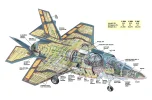The U.S. Navy is carefully backing away from the troubled F-35 Joint Strike Fighter program — and putting in place a backup plan in case the trillion-dollar, jack-of-all-trades stealth jet can’t recover from mounting technical and budgetary woes. So much for the F-35 being too big to fail.
The Navy’s Plan B is still taking shape. But its outlines are coming into view, thanks in large part to recent comments from its top officer. It involves fewer F-35s (the Navy’ll still buy some) and more copies of the older Boeing F/A-18E/F Super Hornet carrier-based fighter, which the Lockheed Martin-built F-35 was originally meant to replace. In the unlikely event the F-35C — the naval version of the radar-evading plane — gets canceled, the Super Hornet could be upgraded past its current shelf life. The twin-engine F/A-18E/F is already getting new weapons. Extra fuel tanks and some stealth treatments could be added as well.
The Joint Strike Fighter program is many billions of dollars over budget and years behind schedule; it probably can’t deliver a single combat-ready warplane to the Navy before 2018. The Navy has long been the least enthusiastic of the Joint Strike Fighter’s U.S. customers, which also include the Air Force and Marines, each with their own unique variant of the F-35. Since the sailing branch has the youngest fighter force in the military, it has the least urgent need for factory-fresh planes.
And the Navy downplays radar-eluding stealth capability in its war plans, instead preferring to fight its way through enemy defenses or fire weapons from a distance. “It is time to consider shifting our focus from platforms that rely solely on stealth to also include concepts for operating farther from adversaries using standoff weapons and unmanned systems — or employing electronic-warfare payloads to confuse or jam threat sensors rather than trying to hide from them,” Adm. Jonathan Greenert wrote last year in the U.S. Naval Institute journal Proceedings.
Greenert, the Navy’s top officer, is a case study in the Navy’s ambivalence about the Joint Strike Fighter. His Proceedings piece was interpreted as a shot across the F-35′s bow, but Greenert denies he meant any such thing. “We need the F-35C; we need its capability,” Greenert said two weeks ago. “It has stealth, range, big payload capacity and an enormous electronic attack (potential).”
But in the same breath, Greenert hinted that the Navy might buy fewer F-35Cs than the current 260 on order. “The question becomes how many do we buy, and how does it integrate into the air wing,” he said, adding that totally canceling the new plane is unlikely for political reasons. “If we bought no Cs that would be very detrimental to the overall program.”
Any reduction in the number of Joint Strike Fighters purchased subtracts from Lockheed’s intricately laid-out production plan, therefore increasing the cost of the remaining jets. However, buying fewer F-35Cs and more improved F/A-18s might be possible without utterly wrecking the Joint Strike Fighter program.
A Pentagon analysis obtained by Reuters found that reducing the Pentagon’s overall acquisition of F-35s from 2,400 copies to just 1,500 would increase the per-unit price of the remaining planes just nine percent. Today a single F-35 costs more than $100 million and an F/A-18 around half that much. Swapping F-35Cs for Super Hornets could save the Navy, and by extension the Pentagon, billions of dollars. Not to mention the Navy is already thinking about a brand-new fighter design to come after both the JSF and Super Hornet.
With improvements, the Super Hornet could equal the Joint Strike Fighter’s combat capability, albeit with different tactics — and, admittedly, this is highly debatable. The Navy is working to make the F/A-18E/F a long-range missile-hauler with some optional stealth qualities, as opposed to the fully stealthy F-35 designed to slip past enemy defenses at close range and drop guided bombs before sneaking away.
The Navy has already budgeted for a new 500-mile-range anti-ship and land-attack missile for the Super Hornet and this year will also be testing overwing fuel tanks that could add hundreds of miles to the jet’s range, possibly allowing it to out-distance the F-35. The F/A-18E/F could also get extra radar-absorbing coatings and a stealthy underbelly pod for carrying all its weapons — though the Navy has yet to fund these options.
In many ways, a shift from the F-35 to an enhanced F/A-18 is the comfortable move for the Navy. The sailing branch has long favored the kind of stand-up fighting the Super Hornet is best at. While current Air Force war plans call for F-22 and B-2 stealth planes to covertly infiltrate enemy territory, the Navy foresees using radio noise-generating Growler jamming planes to overwhelm enemy defenses and allow the Super Hornets to strike.
For the flying branch, adding stealthy F-35s does not mean fundamentally altering its strategy, whereas the Navy would be forced to rewrite decades-old doctrine.
In any event, the Navy can afford to wait and see whether the Joint Strike Fighter overcomes its recent groundings, performance downgrades and other problems. Boeing’s St. Louis Super Hornet factory has enough orders to keep its lights on into 2015, after which the Navy could put into effect some version of its aviation plan B. Or it can cast its lot with the more risky F-35.




